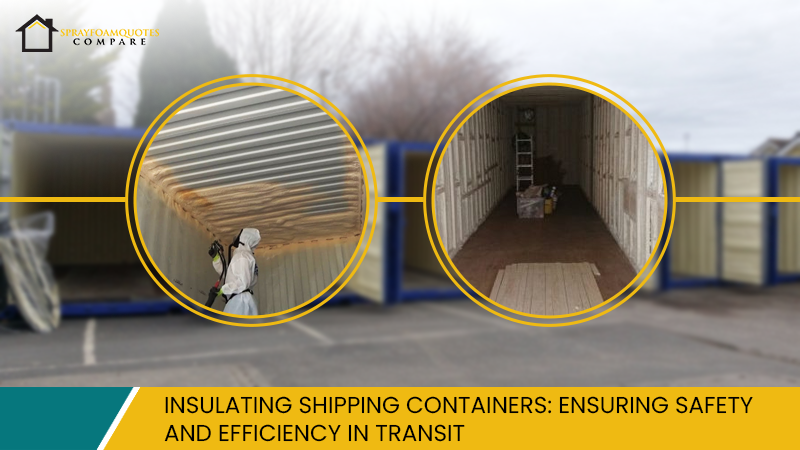A. Importance of Insulating Shipping Containers
Insulating shipping containers is a critical aspect of cargo transport. It ensures the safety and integrity of goods during transit, especially when they are sensitive to temperature fluctuations. Insulation helps in maintaining a stable internal environment, protecting the contents from external weather conditions.
B. Significance in Protecting Goods During Transit
The proper insulation of shipping containers is vital for protecting goods from damage due to temperature extremes, humidity, and condensation. This is particularly important for perishable items, electronics, and other sensitive materials.
C. Energy Efficiency Considerations
Using insulated containers also contributes to energy efficiency. It reduces the need for additional cooling or heating systems within the container, leading to lower energy consumption and cost savings.
Types of Insulation Materials
A. Common Insulation Materials for Shipping Containers
Foam Board Insulation: Rigid panels of insulation offering good thermal resistance.
Fiberglass Insulation: Consists of fine glass fibers and is commonly used due to its fire resistance and thermal properties.
Spray Foam Insulation: Provides an airtight seal and is excellent for filling gaps and uneven surfaces.
Reflective Foil Insulation: Reflects heat and is useful in protecting against radiant heat.
B. Pros and Cons of Each Insulation Material
Each insulation type has its advantages and disadvantages, such as cost, installation complexity, and effectiveness in different climates.
C. Factors Influencing the Choice of Insulation Material
The choice of insulation material is influenced by factors such as the type of cargo, destination climate, and the container’s size and design.
Benefits of Shipping Container Insulation
A. Temperature Control
Protection Against Extreme Temperatures: Insulation protects contents from extreme cold and heat.
Minimizing Temperature Fluctuations: It helps in maintaining a consistent temperature inside the container.
B. Moisture Control
Preventing Condensation and Humidity Damage: Insulation reduces the risk of condensation, thus preventing damage to the cargo.
Mold and Mildew Prevention: By controlling humidity, insulation helps prevent the growth of mold and mildew.
C. Improved Energy Efficiency
Reducing Heating and Cooling Costs: Insulation reduces the need for additional temperature control measures.
Sustainable and Environmentally Friendly Options: Certain insulation materials are more eco-friendly, contributing to sustainable transport practices.
Installation Process
A. Preparing the Shipping Container
Before insulation, the container must be thoroughly cleaned and prepped, ensuring no moisture or debris is present.
B. Choosing the Right Insulation Method
The insulation method should be chosen based on the cargo, budget, and specific requirements of the shipment.
C. Step-by-Step Installation Guide
Cleaning and Prepping the Surface: Ensuring the interior surfaces are clean and ready for insulation.
Applying Insulation Material: Depending on the chosen material, this step involves fixing panels, spraying foam, or applying reflective sheets.
Sealing Gaps and Joints: Ensuring all gaps are sealed for maximum insulation efficiency.
Installing a Vapor Barrier: A vapor barrier helps in preventing moisture ingress.
Considerations for Specific Cargo
A. Perishable Goods
Special attention is needed for insulating containers carrying perishable goods to maintain freshness and prevent spoilage.
B. Electronics and Sensitive Equipment
For electronics and sensitive equipment, stable temperatures and humidity control are crucial to prevent damage.
C. Hazardous Materials
When transporting hazardous materials, insulation must meet specific safety standards to prevent reactions caused by temperature changes.
Cost Considerations
A. Budgeting for Insulation Materials
Understanding the cost of different insulation materials and methods is essential for effective budgeting.
B. Potential Cost Savings Over Time
Investing in proper insulation can lead to significant cost savings over time through reduced cargo damage and energy efficiency.
C. Return on Investment Considerations
Considering the long-term benefits and potential ROI is important when deciding on insulation solutions.
Conclusion
A. Summary of Key Points
Recapping the importance of insulating shipping containers and the benefits it brings to cargo safety and energy efficiency.
B. Encouraging the Adoption of Insulation for Shipping Containers
Promoting the use of insulation in shipping containers can significantly improve the quality and safety of transported goods.
C. Final Thoughts on the Future of Insulated Shipping Containers
As technology advances, the use of insulated shipping containers is likely to become more prevalent, playing a key role in the future of cargo transportation.


